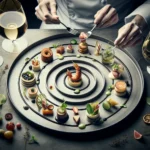The Art of Pairing Wine with Fine Dining Cuisine
Pairing wine with fine dining cuisine is an art form that can elevate the dining experience to new heights. The careful selection of the right wine to complement a dish can enhance the flavors and create a harmonious balance on the palate.
When it comes to pairing wine with fine dining cuisine, there are a few key principles to keep in mind. Firstly, it’s essential to consider the intensity of the flavors in both the food and the wine. For example, a rich and bold red wine may overpower delicate seafood, while a light and crisp white wine might get lost when paired with a heavily seasoned dish.
Another important factor to consider is the acidity of the wine. High-acid wines can help cut through the richness of fatty foods, making them an excellent choice for dishes such as creamy sauces or buttery seafood. On the other hand, low-acid wines may complement lighter, more subtly flavored dishes.
Furthermore, the tannins in red wines can interact with proteins in meat, creating a delightful sensation on the palate. A well-aged, tannic wine can be the perfect accompaniment to a perfectly seared steak or a braised lamb dish.
Additionally, the region where the wine is produced can play a significant role in its pairing with fine dining cuisine. Wines from certain regions often have a natural affinity for the local cuisine, as they have evolved together over time. For example, a classic French Bordeaux can be an excellent match for a hearty beef bourguignon, while a spicy Indian curry might be best complemented by a fragrant Gewürztraminer from Alsace.
In conclusion, the art of pairing wine with fine dining cuisine involves a careful consideration of flavors, acidity, tannins, and regional affinities. When done thoughtfully, the right wine can elevate a dish and create a truly memorable dining experience.
Exploring the Intricacies of Plating in Fine Dining
Exploring the Intricacies of Plating in Fine Dining
Fine dining goes beyond just the taste of the food – it is an entire sensory experience, and plating plays a pivotal role in this. The presentation of a dish can elevate a meal from good to extraordinary, and chefs in fine dining establishments understand the intricate art of plating. Each element on the plate is carefully considered, from the colors and shapes to the arrangement and negative space.
One of the fundamental aspects of plating in fine dining is balance. Chefs strive to create a harmonious composition that balances different textures and flavors. This might involve contrasting smooth and crunchy elements or combining sweet and savory flavors in a single dish. Moreover, the use of contrasting colors, such as vibrant greens against a dark backdrop, can make the dish visually stunning.
Another crucial factor in plating is attention to detail. Every component of the dish is meticulously placed to create a visually appealing and balanced presentation. From the angle at which a piece of protein is positioned to the placement of microgreens, every detail matters. Fine dining chefs often draw inspiration from nature and art to create visually stunning arrangements that are almost too beautiful to eat.
Furthermore, the use of negative space is a defining feature of fine dining plating. Chefs understand that the empty space on the plate is just as important as the food itself. This can create a sense of elegance and sophistication in the presentation, allowing the dish to stand out and the elements to shine.
In essence, plating in fine dining is a thoughtful and deliberate process that elevates the dining experience. It is a fusion of culinary expertise and artistic expression, aimed at delighting not only the taste buds but also the eyes. The next time you dine at a fine establishment, take a moment to appreciate the meticulous artistry that goes into presenting each dish – it’s a feast for the senses in every sense of the word.
Remember to elements of balance, detail, color, and negative space play vital roles in the art of plating. These aspects ultimately contribute to the overall experience of fine dining cuisine, allowing guests to savor not only the flavors but also the visual masterpieces before them.
Unraveling the History of Fine Dining Cuisine
Unveiling the Secrets of Fine Dining Cuisine is a journey that takes us through the rich history of culinary excellence. To truly appreciate the art of fine dining, it is essential to unravel the history and evolution of this sophisticated cuisine. The roots of fine dining can be traced back to ancient civilizations such as the Greeks and Romans, who laid the groundwork for the elaborate dining experiences we know today.
During the Middle Ages, fine dining took on a new dimension as royal courts and noble households showcased their wealth and power through extravagant feasts. The Renaissance period witnessed a refinement of culinary techniques and an emphasis on the aesthetics of dining, leading to the birth of haute cuisine in France.
As culinary traditions traveled across borders and cultures, fine dining evolved into a global phenomenon, with each region contributing its own unique flavors and culinary customs. The 20th century saw the rise of renowned chefs who revolutionized fine dining, elevating it to an art form that celebrates creativity and innovation.
Today, fine dining cuisine continues to captivate and inspire, blending tradition with modern influences to create unforgettable dining experiences. Understanding the historical journey of fine dining allows us to appreciate the depth of flavors, the meticulous presentation, and the cultural significance embedded in every dish.
Delving into the history of fine dining cuisine unveils a tapestry of traditions, innovations, and the relentless pursuit of culinary perfection, making it a truly enriching experience for food enthusiasts and historians alike.




